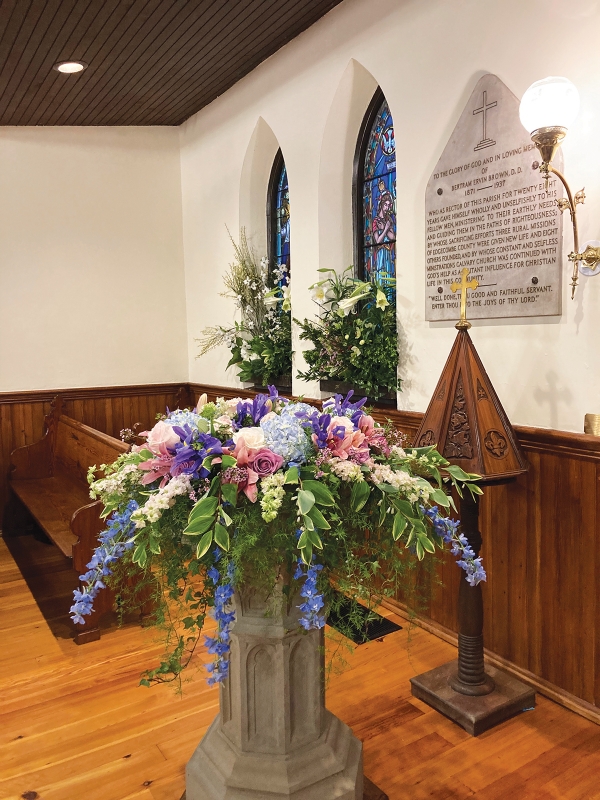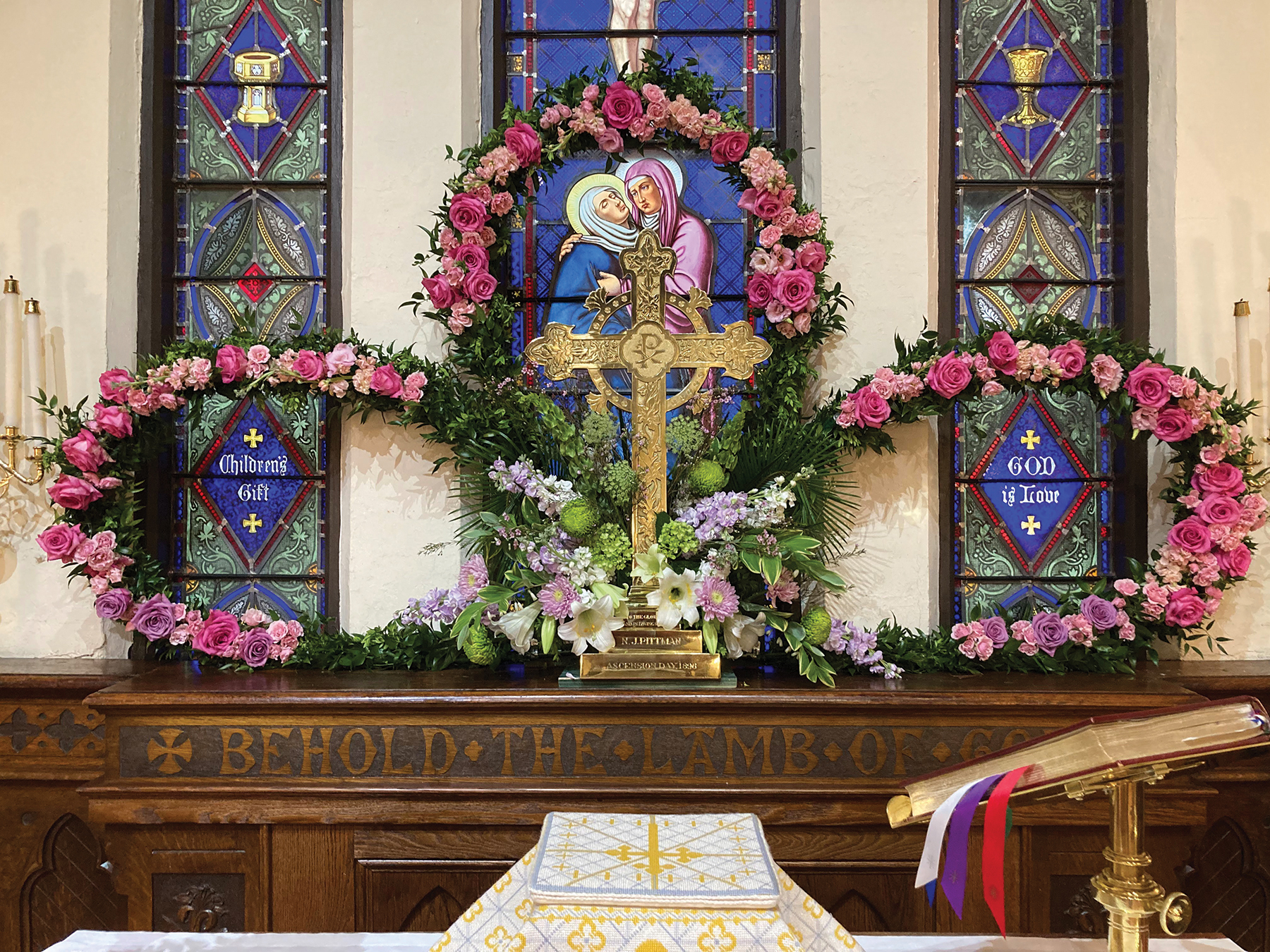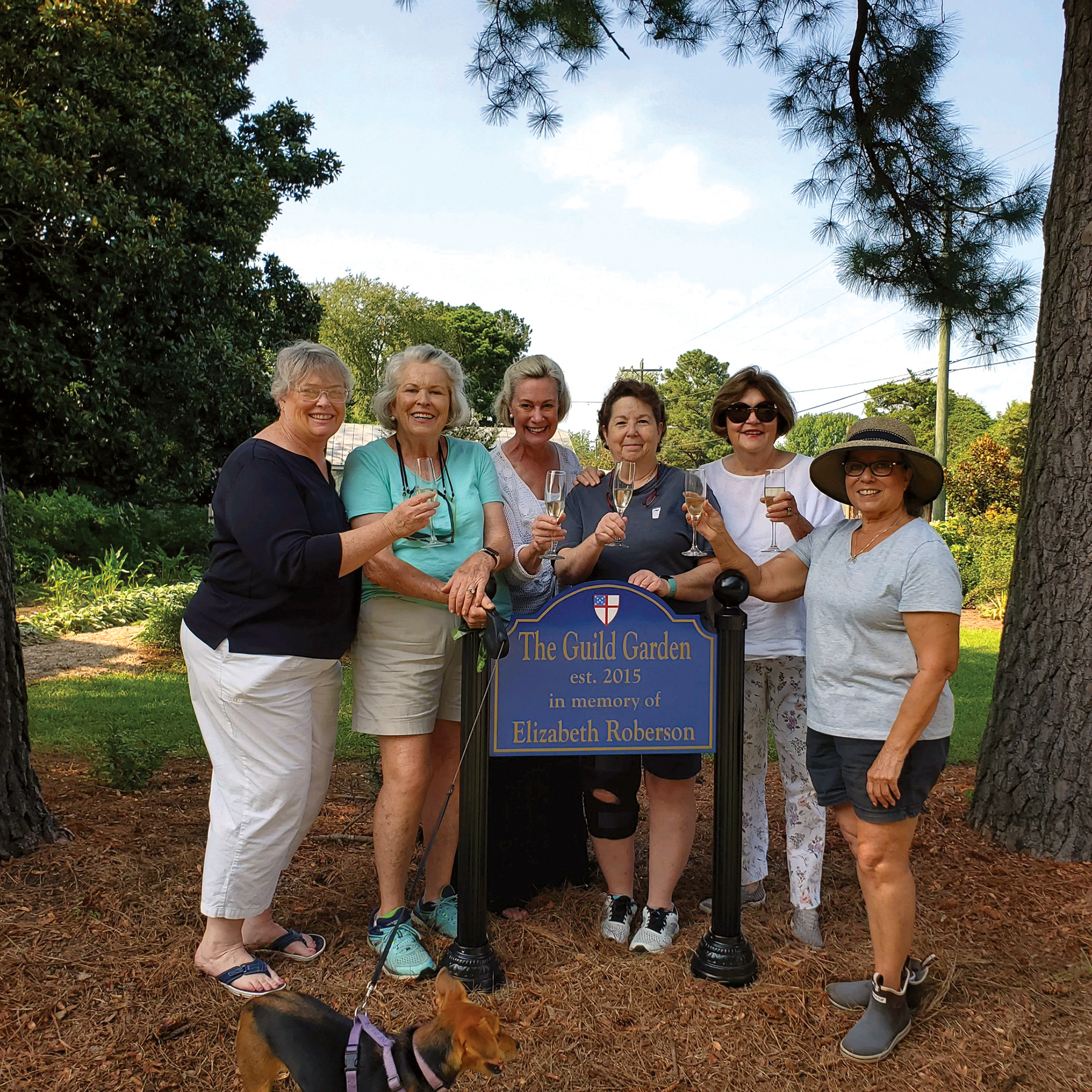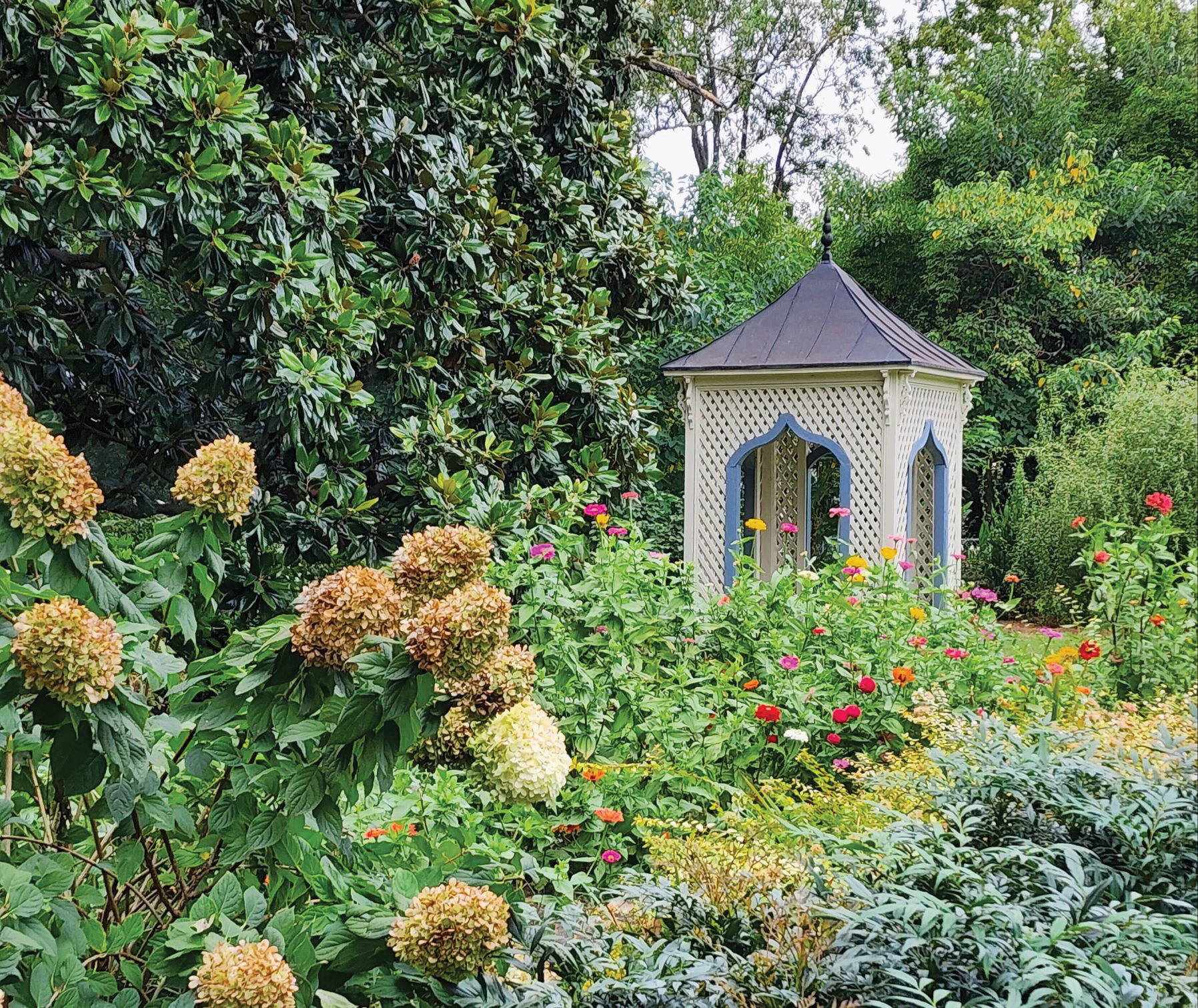Disciple: A Living Testament

How the cutting garden at Calvary, Tarboro, honors its parishioners
By Summerlee Walter
On Good Friday, the altar in the sanctuary at Calvary, Tarboro, looked appropriately somber: dry branches, lichen, shells—detritus, as flower guild member Anne Urquhart described it. By Easter morning, however, it had transformed into a breathtaking explosion of pink and purple roses in the shape of a Triquetra spanning the width of the altar and framing the cross, from which Easter lilies, green hydrangeas and purple hyacinths seemed to explode. More roses, purple irises and periwinkle hydrangeas spilled gracefully out of the baptismal font, and a floral archway greeted worshipers at the front door.
[Image: An overflowing baptismal font welcomed worshipers on Easter morning.]
The nontraditional botanical arrangements on display throughout Holy Week were the work of the church’s dedicated flower guild, whose members have always created the arrangements for Calvary’s worship services in lieu of hiring a local florist. Up until 2015, their creations followed a consistent pattern: two heavy brass urns filled with greenery and flowers teased into triangles measuring less than 30 inches tall, orderly and symmetrical, never higher than the altar cross. That changed when a few members of the flower guild travelled to Grace Church Cathedral in Charleston, South Carolina, for the biennial Fall Flower Festival, which features internationally known floral designers and public displays of the dozens of arrangements created during the workshops. They came back inspired to design something new and creative. The Rev. Bill Smyth, Calvary’s rector at the time, supported their creativity and removed some of the self-imposed rules the flower guild had been following.
“Bill Smyth’s words were, ‘Whatever you put at the altar should honor the cross and not obscure it. I don’t care if it’s taller than the cross, as long as it honors the cross,’” Urquhart recalled.
The flower guild’s creations point not only to the cross, however, but also toward the gathered community. Using cuttings donated from parishioners’ yards and gardens, members of the flower guild create designs that reflect the congregation’s gifts and skills in the garden. Eight years ago, they had the opportunity to expand those gifts in one of those rare moments when vision and the necessary resources arrive at the same time.

[Image: This spectacular Easter Sunday altar arrangement is but one example of the botanical talent found among members of the altar guild and garden guild at Calvary, Tarboro. Photos throughout by Anne Urquhart]
A GROWTH OPPORTUNITY
Calvary acquired the historic Mathewson House and the adjacent empty lot that sits across the street from the church’s parish house around the same time members of the guild started their biennial pilgrimage to Charleston. While the vestry went to work discerning what to do with the empty lot—“a weed patch,” as Urquhart described it—Jane Thorne went to work on the vestry. A member of the flower guild, Thorne made a modest request: Might the flower guild have a little seed money and use a portion of the lot, maybe a 2-3-foot border around the edge, as a cutting garden to supply greenery and flowers for the altar? She received the requested allotment, and thus began more than a year of planning, soil amendment and mulching before the first plants went into the ground in 2017.

While the vestry considered expanding the church burial ground into the empty lot, they eventually decided to leave the property undeveloped. The flower guild continued to campaign for more space in the lot until the vestry eventually gave them the whole thing to plant and tend. A core group of 5-6 members of the guild joined with parishioner Ann Elise Kent to expand the garden. Kent and her family gave the initial donation—and lots of sweat equity—to establish the garden in honor of her mother, the late Elizabeth “Libba” Roberson, a longtime, dedicated member of the altar guild and flower guild after whom the garden is named.
Now, the lot overflows with 40-45 different varieties of mostly native eastern North Carolina plants, many grown from cuttings and divisions from parishioners’ yards and gardens: Lenten roses, little gem magnolias, poet’s laurel, peonies, ginger lilies, lamb’s ears, fatsia from a parishioner who moved to South Carolina, Solomon’s seals, weigelas, viburnums, mahonias, three varieties of hydrangeas and an abundance of camellias. The palms for Palm Sunday (and next year’s ashes for Ash Wednesday) came from the fan palms in the garden. Recently a parishioner asked to donate cuttings of an althea, or rose of Sharon bush, that his mother received from her grandmother, as a way to represent his mother in the garden.
[Image: Members of the garden guild prepared and dedicated The Guild Garden throughout 2015-2017.]
“Not everyone needs to be buried at Calvary to be planted in our dirt,” Urquhart said.
Because it’s a cutting garden, designed specifically to produce foliage and blooms for ongoing harvest, Calvary’s garden constantly changes and evolves. As Urquhart explained, “it will never be finished.”
“It is truly a cutting garden; it’s a working garden. Some things happen to bloom, but that’s not necessarily why we planted them. We planted them for their foliage and to be whacked away at. We cut, and we use, and have a great time with it.”

[Image: The Calvary cutting garden provides foliage and blooms throughout the year.]
The garden guild is discerning future additions to the garden, including the possibility of building a labyrinth. They already moved the dilapidated summer house from behind the Mathewson House into the garden and refurbished it into a resting spot. And, of course, they constantly add new plants, divide what’s there, and cut what they need for the altar.
Now members of the garden guild want to share their knowledge and love of floral arrangement with the wider diocese. With some help from their friends at Grace Church Cathedral in Charleston, Calvary will host its own Festival of Flowers in November, and the entire diocese is invited. Learn more at tinyurl.com/festivalofflowers23.
A FESTIVAL OF FLOWERS
You’re invited to the 2023 Festival of Flowers presented by Calvary, Tarboro on November 3. Beginning at 8:30 a.m. and ending around 2:30 p.m., the event will include flower arranging demonstrations by the flower guild of Grace Church Cathedral in Charleston, South Carolina, and an afternoon address and book signing by keynote speaker Frances Schultz (www.francesschultz.com). For more information and to purchase tickets, visit tinyurl.com/festivalofflowers23. If you wish to pay by cash or check, tickets can be purchased in Calvary’s Office at 411 E. Church Street or by phone at (252) 823-8192.
CHESHIRE'S ARBORETUM
The cutting garden isn’t the only going botanical concern at Calvary. The church yard is also a level 1 arboretum, which means it has at least 25 different species of trees identified and labelled for the purpose of educating the public. The collection began with the work of the Rev. Dr. Joseph Blount Cheshire, Calvary’s third rector and father of the Rt. Rev. Jospeh Blount Cheshire, the diocese’s fifth bishop.
At the time of its consecration in 1868, the current church building sat in an empty dirt lot, which Cheshire decided to enliven with plants. He wrote to fellow priests around the globe who were serving churches situated along the same latitude as Calvary and asked them to send seeds and cuttings, which he then planted throughout the churchyard. He cultivated ivy from Kenilworth Castle in England and a cork tree from Spain (which recently died but left behind offspring). In a testament to his skill as a gardener, Cheshire even managed to grow a cedar of Lebanon by grafting a seedling onto the seedling of a native species of cedar.
Today the arboretum and the burial grounds are intertwined, making the church grounds a living testament to generations of Calvary parishioners.
Summerlee Walter is the communications coordinator for the Diocese of North Carolina.
Tags: North Carolina Disciple
